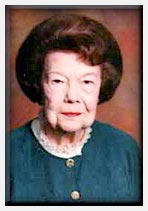The Warners Brought Culture and Enjoyment to the Panhandle |
|
 Eloise Lane
Eloise Lane
In 1897 Doctor William Arthur Warner came from his native Illinois to practice medicine within a radius of thirty-five miles from the small community of Claude, Texas. He was familiar with the area because, in 1870, his father, the Reverend Peter Warren, had purchased land in Armstrong County for thirty-three and one-third cents an acre. Doctor Warner was educated at Wesleyan College in Bloomington, Illinois and Northwestern Medical College at Chicago. His first practice was in his home town of LaFayette, Illinois. At first, Doctor Warner traveled to his Texas patients in a buggy drawn by his horse, Old Scarleg, survivor of a roaring prairie fire. Later the doctor drove one of the first cars in the neighborhood. With its high wheels, single seat, leather upholstery and raucous horn, the car created much excitement when it was seen coming down the street. It has been estimated that Doctor Warner delivered two thousand babies during his years on the Plains. His life was an endless round of calls and midnight rides across the prairie with only stars or a flickering light in a settler's window to guide him. His work was so demanding that he could not find time to return to Illinois to marry his college sweetheart, So ---, on February 17, 1898, he met Phebe Kerrick at the Santa Fe depot in Panhandle City, and they were married that night in the home he had purchased at Claude. Phebe Kerrick was reared to meet and conquer every challenge of life. She worked her way through Wesleyan University where she was a member of Kappa Alpha Theta and Phi Kappa Phi. She held the Chair of Science in the Illinois Women's College for three years and was credited with establishing the Natural Science Department there. After their marriage Phebe K. and Doctor Warner brought a new dimension in culture and enjoyment to all the Plains area. The Warner Drug, known as the "Gate City Drug Store," erected at Claude in 1909, was much more than a drug store. The building contained the town's first soda fountain, a reading room and meeting room for clubs and lodges, public rest rooms to serve the entire community, the office of the Claude News, and Earl Blanton’s Barber Shop. After the building burned in 1915, it was replaced with a Community Hall which was later designated as a memorial to the Warners in remembrance of their many efforts to enlighten and benefit their townsmen. In addition to ministering to the physical needs of the community, Doctor Warner organized the first Boy Scout troop west of the Mississippi. The troop, organized in Armstrong County in 1912, was Lone Star Troop 17. Doctor Warner was Scoutmaster for twenty years and was awarded the Silver Beaver Award, the highest honor Scouting can bestow. Phebe was challenged by the needs of rural women. Realizing that most settlers were lonely for their former homes, she organized the first women's club in the Panhandle of Texas. Through her efforts, Home Demonstration agents were brought to Panhandle counties. She was associated with the Texas Federation of Women's Clubs and Texas Women's Press Association. For nineteen years, 1916 to, 1935, Phebe K. Warner wrote editorials for Texas newspapers. These editorials reflect her deep concern and ambitions for her beloved Texas -- its rural women and rural schools; its boys and girls; its farms, farmers, cattlemen, stock and crops; its parks and railroads and its politics. Her writings referring to Palo Duro Canyon as "one of nature' s rarest: scenic gifts here in the heart of the Texas Panhandle" were widely read and very effective. When writer Loula Grace Erdman first came to the Panhandle, she told Phebe that she would like the country better if the wind didn't blow so much. Phebe told her, "Don't fuss about the wind. It's what has made it possible for our kind of people to stay here." Later Erdman said of Phebe, "She was like the prairie wind - vigorous, restless, searching, giving freely without asking anything in return." Having brown hair and eyes and an olive complexion, Phebe was affectionately known as "the little brown wren of the Panhandle." Wes Izzard, at one time editor of Amarillo Daily News, said that her influence was mighty. Phebe and Doctor: Warner had two daughters, Kerrick and Victoria, and two sons, William and Greeley. Victoria W. Tappan compiled "Selected Editorials" by Phebe K. Warner in 1964. Pampa residents John W. Warner and Kerrick Warner Horton are grandchildren of Phebe and Doctor Warner. John W, Warner has given a copy of "Selected Editions" to the White Deer Land Museum.
(Much of the information in this article was obtained from A Time to Purpose: A Chronicle of Carson County, Vol, III, pp. 228-229.)
(Much of the information in this article was obtained from A Time to Purpose: A Chronicle of Carson County, Vol, III, pp. 228-229.)

